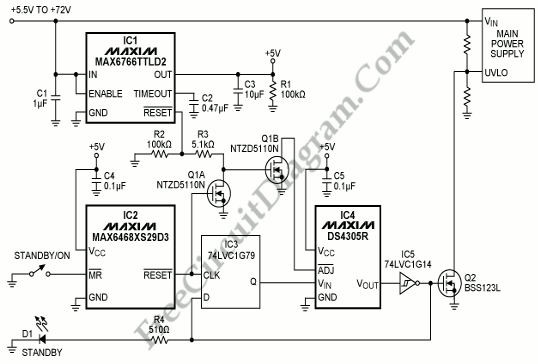Nonvolatile STANDBY/ON Switch

STANDBY/ON switch below is appropriate for applications (industrial and telecom, for example) in which the circuitry must remember its state (STANDBY or ON) after a power failure that occurs when there is no operator. Because the state can be lost if leakage current drains the battery, we can not just rely on an alternative approach based on battery (or supercapacitor) and flip-flop. The other way is involving the use of a microcontroller and EEPROM, but software and a provision for startup time is required. A stand-alone EEPROM has an awkward interface for this application.
An electronically programmable voltage reference (IC4, DS4305) is used as a single-bit nonvolatile memory cell, that’s the idea. This device can be reprogrammed minimum of 50.000 times to remember the state of the STANDBY/ON switch, high or low output voltage. Here’s the circuit diagram:

IC1 (MAX6766) is a kind of low-dropout (LDO) linear regulator with RESET output and the wide input-voltage range can be extended up to 72V. The control button (STANDBY/ON pushbutton) bounces can be eliminate by a uP (IC2,MAX6468). This IC supports the programming of IC4 by increasing the pause length between pulses. An inverter with Schmitt-trigger input(IC5) is driven by IC4 output, which in turn drives the gate of transistor Q2 to control the main power supply. [Source: MAXIM Application Note]
STANDBY/ON switch below is appropriate for applications (industrial and telecom, for example) in which the circuitry must remember its state ( STANDBY or ON ) after a power failure that occurs when there is no operator.